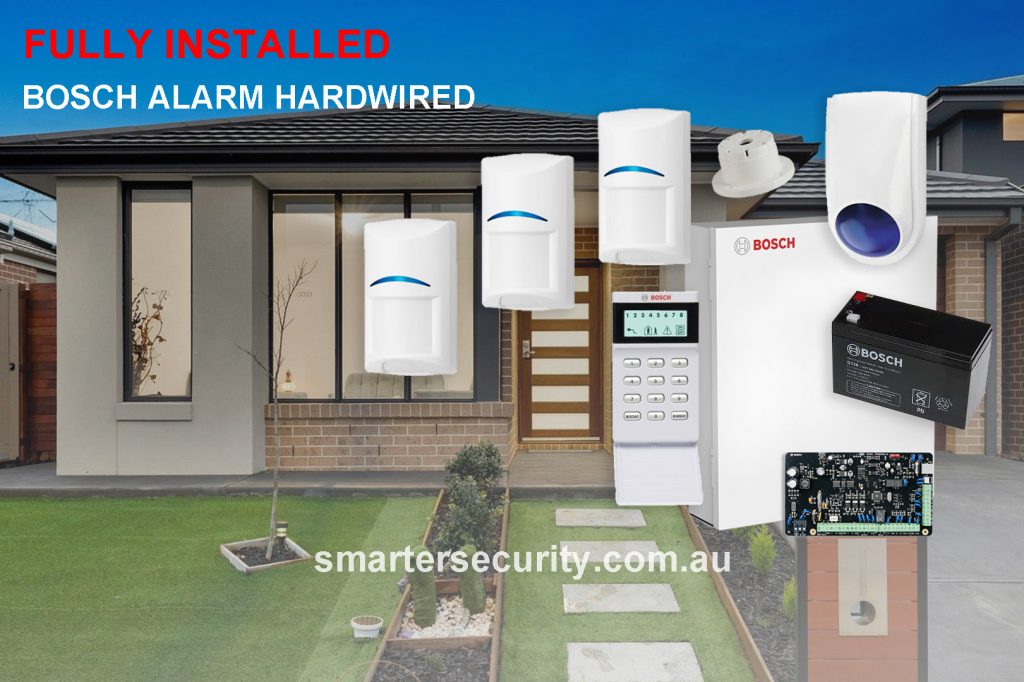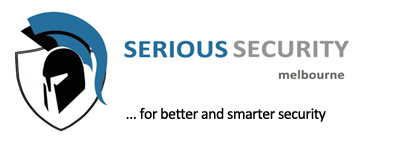Alarm Pack 1 – Designed for Single Storey Homes – $990 Fully Installed (over 50% of our new alarm customers choose this)

- Bosch Solution 3000 (8 zone capable, up to 8 PIRs) Alarm panel with tamper switch
- 3 x Bosch Blue line Hard Gen2 wired movement detectors (PIRs)
- 1 x External slimline siren with blue strobe
- 1x Internal siren (105db+) (piezo)
- Power pack & backup battery
- LCD Icon Keypad
- Cables & connectors
- 2 year parts & labour warranty
Notification Options
- OPTION 1 – SIM CARD OPTION – Add a 4G GSM Module for an additional $330 (uses the sim card to dial out and ring your phone for notification).
- OPTION 2 – ETHERNET MODULE – Arm / Disarm / Notifications via app. View more about the module / app here $440
Optional Extras
- Additional motion sensors are $110 each
- Reed switches for doors / windows are $110 each.
- Pet Friendly sensors Under 15kg = $45 extra per sensor, under 40kg = $95 extra per sensor.
- Upgrade to a Bosch 5″ Touchscreen for $220 (only available on Bosch 3000)
- Upgrade to a Bosch 7″ Touchscreen for $390 (only available on Bosch 3000)
- Wired Smoke Alarms – never have to change the battery again = +$165
- 2x Bosch Remote controls and Receiver (with panic function) +$195
- Glass Break Detector (designed to protect a small set of windows) +$165
- Upgrade to Bosch Solution 6000 Alarm panel for an extra $250 (more zones, more access control, made in Australia)
- Read about the difference between choosing the Bosch 3000 vs 6000
We can usually squeeze you in within 1-2 weeks. We have a large team of experienced licensed installers. Sometimes, we have spare capacity so if your install is urgent, simply let us know and we’ll try and squeeze you in for the earliest convenient time for you. Most alarm installs take between 4-6 hours. So if we start at 8am, we will usually be done by lunch time. Most of the time, we find that builders don’t like it when other companies do work before they’ve handed the premises over. Thats OK, because we can still work on the home once the house is fully completed as long as there is some roof space for us to get in and run the cables. If its a non standard install eg. double storey home and you prefer a completely wired system, then we recommend cabling up the job before the walls go up. Seek the advice of your builder and let us know if its OK and we’ll run the cables pre wall stage and come back once the house is complete to hook the system up. Our predesigned packages are based on popularity. If the purposes is to protect your premises from someone roaming around when you’re not home, then these packages are likely to suffice. The detectors will usually go into the common areas of the premises – these are the areas a burglar would usually go to – to look for valuables. Feel free to add more detectors if your location is large. If you’re interested in more protection and want sensors on your doors and windows, just add the cost of the reed switches to the current package prices. In a wired system, the sensors communicate with the control panel via cables. The wireless system’s sensors communicates wireless-ly and uses ultra long lasting batteries (usually 5 years). For single storey homes where there is a roof cavity, we will be recommending a wired system. The wired system’s cables will run along the roof space. For homes without a roof space or non pre-wired double storey homes, we recommend a wireless system as in most cases this is the only way we can install sensors without the wires running along the wall/ceilings. The wireless sensors are very reliable and have a range of up to 100m. A zone in alarm terminology is essentially a slot for a sensor. So an 8 zone alarm can have 8 sensors. A 16 zone alarm can handle up to 16 sensors. Alarm pack 1 for instance has 3 sensors, so its using 3 of those 8. You can have another 5 sensors on that alarm should you choose to extend it. Our home alarm systems give you the option to program zones so that sensors assigned to them cause the system to respond differently when they are triggered. All the alarms we offer can handle “Stay at home” mode and “Away mode”. This allows you to have certain areas of the home armed while you are at home. The technician will organise this for you on the day of the install. Your alarm when triggered will make a deafening sound for around 10 minutes. If you have a phone line and we will connect it up to your phone line so that it rings up to three numbers when an alarm is triggered. When the call is picked up, it will make a siren noise to let you know the alarm has been triggered. This is the most popular option. If you choose to add Back to base monitoring, then an alarm monitoring centre will call your mobiles to let you know. They may then send out a security car to check up on the property for a fee. All our Bosch alarm systems we use come with a 2 year Parts & Labour Warranty, CCTV with a 2 year Warranty. Intercom systems come with a 1 year warranty. If you have any issues, let us know and we will come out and sort it out! Cash, bank deposit and cheque are all OK. This is expected to be paid on completion of the job or other terms as discussed with our team. We also offer credit card payment options, but there is a 2% surcharge. Yes, indeed they are. We believe in simple, straightforward pricing We have sourced many pet-friendly movement sensors, which can easily detect an intruder whilst ignoring a family pet roaming around indoors. Simply let us know that you have indoor pets at the time of quotation and we will advise you on the most suitable sensors for your premises. Yes. After the alarm system has been installed, we will discuss with you some options and recommendations on what part of the alarm (which rooms and doors etc) you should activate before retiring to bed. This will then be programmed by our technician on the day of the installation. Once this has been programmed, the alarm system can be activated in the “stay” mode (often called the “home” mode) by simply pressing one button which will arm key areas of your home whilst leaving other areas turned off to allow you to move around some of the house. All modern alarm systems come complete with a back-up battery, which will continue to run the alarm system without power for many hours. When power has been restored to the property, the alarm system will recharge the battery – in most cases to the same condition it was before the power failure occurred. Should the alarm system be monitored back-to-base, the alarm may send a signal to the 24 hour control room that the power is off. Appropriate action can then be taken. Put simply, the Bosch 3000 is designed for homes, whereas the 6000 is designed for businesses which needs greater reporting / interaction features. Below explains some key differences which may lead you to require the Bosch 6000. Question – How would you like your alarm panel to notify you in the event of alarm? The Bosch 3000 have built in diallers to send domestic dialling signals to you. When you pick up you will hear an alarm noise. It has the ability to ring up to 2 mobiles. No SMS is capable. Question – What happens if I don’t have a phone line? How does the IP Module work? Bosch 3000 app is native Bosch app. No setup or ongoing fees. Bosch 6000 is a third party app. Notification via push notification, pay ongoing fees/subscription No Static IP required for both. Question – What other differences are there?
You may then choose to call your neighbour or family / friends to check up on your property.
The 6000 have built in diallers to connect your home PSTN land line and have the ability to SMS you if your alarm is triggered with zone information. (this is the cost of a premium text)
The Bosch 6000 / Bosch 3000 both have an optional Ness GSM 3G this will call / SMS you. It will require the purchase of a SIM card and you will be billed by your mobile service provider. Lots of our customers choose the Aldi Sim ($5 / 365 day expiry)
Bosch 6000 / Bosch 3000 can have the IP module to connect to the alarm panel.
This will require a cable from the panel to to your home router. The Bosch 6000 also has a wifi keypad which removes the need to run cabling to the router.
Bosch 6000 can have:
> external readers
> proximity tags
> Finger scanner
> Nightarm codepad (dedicated codepad which allows night time arming / disarming)
> ability for lots of user codes
The Bosch 3000 (as its designed for homes, won’t have any of these functions)
